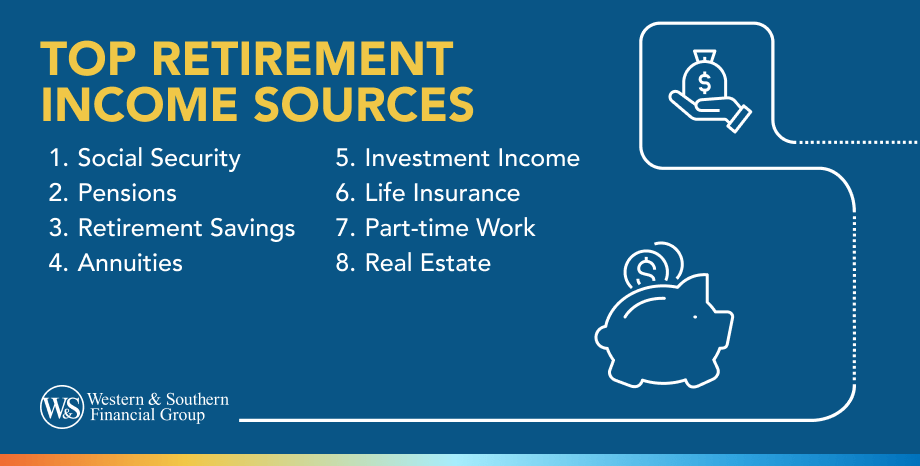

Key Takeaways
- Diversifying your income sources is crucial for a secure retirement.
- Social Security, pensions, and retirement savings form the foundation of retirement income.
- Investments, annuities, and part-time work can supplement your core income sources.
- Understanding the tax implications of different income streams is important.
- A well-planned strategy helps ensure financial stability in retirement.
Retirement income sources are the various streams of income that individuals can rely on during their retirement years. These sources may include Social Security, pensions, investments, annuities, and more. Understanding and diversifying these income sources is critical for helping ensure financial stability, reducing volatility, and positioning yourself for a comfortable lifestyle after you stop working.
Why Diversifying Retirement Income Sources Is Important
When planning for retirement, it's important to understand that relying on a single source of income can be risky. Diversifying your retirement income sources means spreading your financial reliance across multiple income streams and asset classes, such as Social Security, pensions, investments, annuities, rental income, and even part-time work. This strategy offers several key benefits:
- Risk Mitigation: By diversifying income, you reduce the impact of fluctuations in any single source. For example, if the stock market drops and affects your investment returns, having other income streams like Social Security or a pension can help cover your living expenses.
- Protection Against Inflation: Inflation reduces money's purchasing power over time, so depending solely on a fixed income, like a pension, can make you susceptible to rising costs. A diversified portfolio with investments and annuities can help counteract inflation and maintain your purchasing power.
- Financial Stability: It can help create a more stable and predictable cash flow, though all income streams carry some risk. When one source falls short, others can fill the gap, allowing you to enjoy your retirement years comfortably.
Diversifying your retirement income sources is an excellent approach to retirement income and a smart way to help secure long-term financial security, help protect yourself from unforeseen risks and variability in rates of return, and achieve your financial goals.
Common Income Sources
Retirement income is a combination of different sources rather than a single one. Here’s a closer look at the most common potential sources:
1. Social Security Benefits
Social Security is one of the most well-known and reliable income sources. It’s a government program designed to provide a basic income level during retirement.
How to Maximize Social Security Benefits
- Retirement Age: The longer you wait to claim Social Security, the higher your monthly benefit will be. Full retirement age (FRA) ranges from 66 to 67, depending on your birth year. If you delay claiming benefits until age 70, you can receive up to 8% more annually.
- Working While Receiving Benefits: If you continue to work after you start receiving Social Security, your benefits may be reduced temporarily if you haven't reached full retirement age. However, once you reach FRA, your benefits are recalculated, and you can earn more without penalties.
Social Security benefits are taxed based on your combined income, which includes your adjusted gross income, non-taxable interest, and half of your Social Security benefits. If your combined income exceeds certain thresholds, up to 85% of your Social Security benefits may be taxable at your ordinary income tax rate.
By understanding how Social Security works and when to claim it, you can maximize this income source and make it a key pillar of your retirement planning.
2. Pension Income
For retirees lucky enough to have a pension plan, this can be a steady source of lifetime income. Pensions, also known as defined benefit plans, are employer-sponsored programs where the company guarantees a set monthly benefit based on factors like years of service and salary history. However, pensions are becoming less common as many employers have shifted to defined contribution plans like 401(k)s.
Defined Benefit vs. Defined Contribution Plans
- Defined Benefit: The employer bears the investment risk and promises a specific monthly payment for life.
- Defined Contribution: Employees contribute to accounts like a 401(k), and the retirement income depends on the amount saved and the investment's performance.
Pension income is typically taxed as ordinary income, meaning it's subject to the same tax rates as your regular earnings. However, if you made after-tax contributions to your pension, that portion of your payments may be tax-free.
While fewer people today have access to pensions, those who do should consider them a reliable source of retirement income.
3. Retirement Savings
The Power of Tax-Deferred Savings
401(k) and IRA accounts are the next best things for those without pensions. These retirement accounts are important components of your retirement income strategy because they allow your savings to grow tax-deferred or tax-free in the case of a Roth IRA.
- 401(k): Employers often offer a 401(k), which allows employees to contribute pre-tax income, which grows tax-deferred until it’s withdrawn. Employers usually match a portion of contributions, adding to the benefit.
- IRA: An IRA (Individual Retirement Account) allows individuals to save for retirement independently. Traditional IRAs grow tax-deferred, while Roth IRAs grow tax-free, with withdrawals also tax-free after a certain age.
Strategies for Maximizing Retirement Savings
- Max Out Contributions: Take advantage of the contribution limits for 401(k)s and IRAs. For 2024, individuals under 50 can contribute up to $23,000 to a 401(k), and those over 50 can contribute an additional $7,500 as a catch-up contribution. IRA contribution limits for individuals under 50 are $7,000 and $8,000 for those 50 or older.
- Roth Conversions: If you expect to be in a higher tax bracket in the future, consider converting a portion of your Traditional IRA into a Roth IRA for tax-free growth.
Traditional 401(k) and IRA contributions are made pre-tax, reducing your taxable income now, but withdrawals in retirement are taxed as ordinary income. Roth 401(k) and IRA contributions are made with after-tax dollars, so qualified withdrawals in retirement are tax-free.
If funded regularly throughout one's working years, 401(k) and IRA accounts provide substantial retirement income potential.
4. Annuities
Annuities are contracts with insurance companies that provide guaranteed income for life in exchange for a lump-sum payment or a series of payments. This makes them a valuable tool for those who want to help ensure a steady income stream throughout their retirement years, regardless of market conditions.
Types of Annuities
- Fixed Annuities: Provide a guaranteed payout for life or a specified number of years.
- Variable Annuities: Payments fluctuate based on the performance of underlying investments.
- Indexed Annuities: Earnings are tied to the performance of a specific market index, like the S&P 500.
The taxation of annuities depends on the type of annuity and how it was funded. If you used pre-tax money (like from a traditional IRA), the entire payout is taxed as ordinary income. If you used after-tax money, only the earnings portion of the payout is taxed.
Income from annuities helps provide financial security in retirement by mitigating the risk of outliving your savings. Still, it's important to consider the fees, which may be higher than those of other investment products, before investing.
5. Investment Income
Your investment portfolio can provide passive retirement income through dividends and interest from fixed-income instruments. Retirees often rely on these passive income streams to supplement their other sources of retirement income.
- Dividends: Certain dividend stocks and mutual funds pay dividends and offer regular income without selling the investment.
- Interest Income: U.S. Treasury notes, bonds, certificates of deposit (CDs), and high-yield savings accounts can provide steady interest income.
Investment income is taxed differently depending on the source and how long you hold the investment. Interest and dividends are generally taxed as ordinary income, while capital gains from selling assets held for more than a year are often taxed at lower rates.
Building a brokerage account portfolio of income-producing assets with competitive yields can create a growing retirement income stream. Choosing investments that align with your risk tolerance and retirement timeline is important. You should also regularly review your investment strategy with your financial advisor.
6. Life Insurance
Life insurance, while primarily designed to provide a death benefit to your beneficiaries, can also generate retirement income, mainly through permanent life insurance policies like whole life or universal life. Here's how:
- Cash Value Accumulation: Permanent life insurance policies have a cash value component that grows tax-deferred over time. This cash value can be accessed through withdrawals or loans, providing a source of income during retirement.
- Policy Loans: You can borrow against your policy's cash value, often at favorable interest rates. These loans are generally not taxable and can provide income without surrendering the policy. However, unpaid loans will reduce the death benefit.
- Dividends: Some policies pay dividends based on the insurance company's performance. These dividends can be taken as cash, used to reduce premiums, or reinvested to increase the cash value, further enhancing the potential for retirement income.
- Life Insurance Retirement Plan (LIRP): Some individuals use life insurance specifically as a Life Insurance Retirement Plan (LIRP), structuring the policy to maximize cash value growth and using it as an additional income stream during retirement.
Withdrawals from a life insurance policy's cash value are generally tax-free up to the premiums paid, offering a tax-advantaged income stream. A notable advantage over taxable withdrawals from traditional retirement accounts. However, any withdrawals exceeding the premiums paid are considered taxable income.
Life insurance dividends are generally not taxable because they are considered a return of excess premium as long as they do not exceed the total amount of premiums paid. However, if dividends are left to accumulate interest within the policy, the interest earned is taxable as ordinary income.
Life insurance is generally not a primary retirement income source but can act as a tax-advantaged supplement to traditional income sources.
7. Part-time Work
Many retirees work part-time for additional income and to stay engaged and active.
- Part-time work: Retirees often take on consulting roles, freelancing, or part-time jobs that align with their experience or passions.
- Gig Economy: The rise of gig work has also made it easier for retirees to generate extra income on a flexible schedule.
Income from part-time work is generally taxed like any other earned income. This means it's subject to federal and state income tax and Social Security and Medicare taxes, with withholdings typically taken directly from your paycheck.
While part-time work is optional, it can significantly boost your retirement income and help keep you financially secure, especially during early retirement when you might still have high expenses. Ensure that you keep social security in mind to avoid impacting your benefits.
8. Making Your Property Work for You
Real estate is another excellent option for generating retirement income.
- Rental Properties: Owning rental properties allows you to receive rental income from tenants while potentially appreciating in value over time. Rental income is taxed as ordinary income, meaning it's subject to your usual federal and state income tax rates.
- Downsizing: Many retirees downsize their homes, freeing up cash to purchase smaller properties or invest in rental units. When you sell your home, any profit (capital gain) may be taxed.
- Home Equity: A home equity loan or line of credit (HELOC) uses your house as collateral to fund retirement expenses or supplement income.
Though managing real estate can require time and effort, the potential for regular rental income makes it a valuable addition to your retirement income plan.
Conclusion
Retirement income planning requires not only saving but also understanding and utilizing various income sources for long-term financial security.
From Social Security and pensions to investments and annuities, building a diversified portfolio will help you navigate the financial challenges of retirement, unexpected expenses, and the effects of inflation and enjoy the lifestyle you’ve worked so hard to achieve.
Now is the time to take action. Start by evaluating your current income streams, and consider speaking with a financial advisor to ensure you have a solid plan for your retirement.
Prepare for retirement with a plan that helps ensure a steady stream of income and manages risk. Start Your Free Plan
Frequently Asked Questions
What is the most widely used source of retirement income?
What is the 4% rule for retirement income?
The 4% rule suggests withdrawing 4% of your retirement savings annually, adjusted for inflation, to potentially avoid outliving your funds. However, it's a guideline, not a guarantee, and factors like investment returns, life expectancy, and expenses can impact its effectiveness.
Use our calculator to understand how long your retirement savings will last, which is key to determining your retirement income needs.
What is a good monthly retirement income?
Experts suggest a good monthly retirement income typically replaces 70-80% of your pre-retirement income to maintain your lifestyle. However, the ideal amount varies considerably based on individual needs, location, health, and desired retirement spending level.
Understand your income needs with our Retirement Cost of Living Calculator, which compares your current finances to projected expenses.
Sources & Footnotes
- Retirement Ready - Fact Sheet For Workers Ages 61-69 - Social Security Administration February 2023. https://www.ssa.gov/myaccount/assets/materials/workers-61-69.pdf
- Retirement Age Calculator - Social Security Administration March 2023. https://www.ssa.gov/benefits/retirement/planner/ageincrease.html
- Retirement topics - Contributions - Internal Revenue Service (IRS). https://www.irs.gov/retirement-plans/plan-participant-employee/retirement-topics-contributions
- Report on the Economic Well-Being of U.S. Households in 2023 - May 2024 - The Federal Reserve. https://www.federalreserve.gov/publications/2024-economic-well-being-of-us-households-in-2023-retirement-investments.htm
- Payment of benefits under the annuity/life insurance contract is guaranteed by the company based on its claims-paying ability.




























